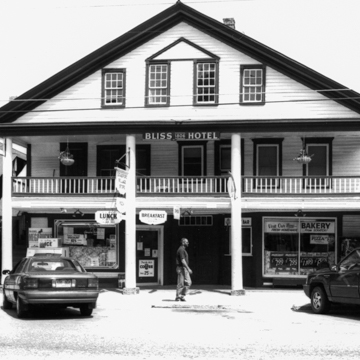Bliss Hotel is a rare survivor in the Connecticut River Valley, an early-nineteenth-century, wood-frame stagecoach hotel. It has a recessed two-story “piazza,” a traveler-oriented feature that was characteristic of early stagecoach hotels throughout the state. Unlike contemporary stagecoach taverns west and north of the valley, this hotel has the broad and low, five-bay gable-front form then becoming popular for large houses in the area, an indication that commercial use and residential use arose in tandem. The hotel retains the name of its most famous proprietor, Ellis Bliss, who ran it from about 1840 until his death in 1870. During his tenure, the top half story, which accommodated one long, coved ballroom, was reportedly the focus of the village's social life, hosting military balls and other dances. By 1900 the building housed three stores, other small shops, and rooms. Today it is a grocery/deli and apartments.
You are here
Bliss Hotel
If SAH Archipedia has been useful to you, please consider supporting it.
SAH Archipedia tells the story of the United States through its buildings, landscapes, and cities. This freely available resource empowers the public with authoritative knowledge that deepens their understanding and appreciation of the built environment. But the Society of Architectural Historians, which created SAH Archipedia with University of Virginia Press, needs your support to maintain the high-caliber research, writing, photography, cartography, editing, design, and programming that make SAH Archipedia a trusted online resource available to all who value the history of place, heritage tourism, and learning.















